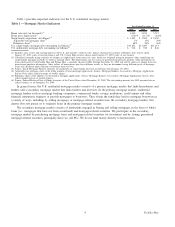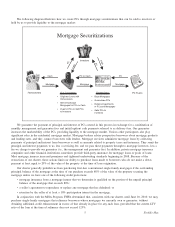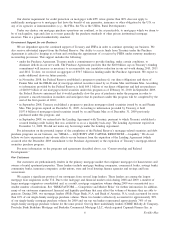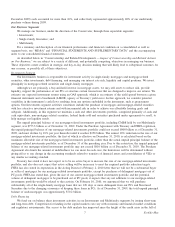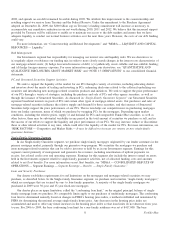Freddie Mac 2009 Annual Report Download - page 17
Download and view the complete annual report
Please find page 17 of the 2009 Freddie Mac annual report below. You can navigate through the pages in the report by either clicking on the pages listed below, or by using the keyword search tool below to find specific information within the annual report.permitted lenders to deliver to us a significant portion of the loans covered by the long-term standby commitments to be
securitized as PCs or Structured Transactions, which totaled $5.7 billion and $19.9 billion in issuances during 2009 and
2008, respectively.
In 2009, we entered into transactions under Treasury’s TCLFI, with certain HFAs for the guarantee of certain variable
rate demand obligations, or VRDOs, issued by the HFAs. In these transactions we do not issue a new security, but issue a
financial guarantee to credit enhance the bonds for investors and provide liquidity support. At the expiration of each of these
facilities, any VRDOs purchased by us will be securitized and sold to Treasury. See “MD&A — MHA PROGRAM AND
OTHER EFFORTS TO ASSIST THE U.S. HOUSING MARKET” for further information.
For information about the amount of mortgage-related securities we have issued, refer to “MD&A — OUR
PORTFOLIOS — Table 79 — Issued Guaranteed PCs and Structured Securities.” For information about the relative
performance of these securities, refer to our “MD&A — RISK MANAGEMENT — Credit Risks” section.
PC Trust Documents
We establish trusts for all of our issued PCs pursuant to our PC master trust agreement. In accordance with the terms of
our PC trust documents, we have the option, and in some instances the requirement, to purchase specified mortgage loans
from the trust. We purchase these mortgages at an amount equal to the current unpaid principal balance, less any outstanding
advances of principal on the mortgage that have been distributed to PC holders. From time to time, we reevaluate our
delinquent loan purchase practices and alter them if circumstances warrant. Through November 2007, our general practice
was to purchase the mortgage loans out of PCs after the loans became 120 days delinquent. Effective December 2007, our
practice is to purchase mortgages from pools underlying our PCs when:
• the mortgages are modified;
• a foreclosure sale occurs;
• the mortgages are delinquent for 24 months; or
• the mortgages are 120 days or more delinquent and the cost of guarantee payments to PC holders, including advances
of interest at the security coupon rate, exceeds the cost of holding the nonperforming loans.
On February 10, 2010, we announced that we will purchase substantially all single-family mortgage loans that are
120 days or more delinquent underlying our issued PCs and Structured Securities. The decision to effect these purchases was
made based on a determination that the cost of guarantee payments to the security holders will exceed the cost of holding
non-performing loans on our consolidated balance sheets. The cost of holding non-performing loans on our consolidated
balance sheets was significantly affected by the required adoption of new amendments to accounting standards and changing
economics. Due to our January 1, 2010 adoption of new accounting standards for transfers of financial assets and the
consolidation of VIEs, the cost of purchasing most delinquent loans from PCs will be less than the cost of continued
guarantee payments to security holders. As of December 31, 2009, the total unpaid principal balance of such mortgages was
approximately $70.2 billion. We will continue to review the economics of purchasing loans 120 days or more delinquent in
the future and we may reevaluate our delinquent loans purchase practices and alter them if circumstances warrant.
In accordance with the terms of our PC trust documents, we are required to purchase a mortgage loan (or, in some
cases, substitute a comparable mortgage loan) from a PC trust in the following situations:
• if a court of competent jurisdiction or a federal government agency, duly authorized to oversee or regulate our
mortgage purchase business, determines that our purchase of the mortgage was unauthorized and a cure is not
practicable without unreasonable effort or expense, or if such a court or government agency requires us to repurchase
the mortgage;
• if a borrower exercises its option to convert the interest rate from an adjustable-rate to a fixed-rate on a convertible
ARM; and
• in the case of balloon-reset loans, shortly before the mortgage reaches its scheduled balloon-reset date.
The To Be Announced (TBA) Market
Because our fixed-rate PCs are homogeneous, issued in high volume and highly liquid, they trade on a “generic” basis
by PC coupon rate, also referred to as trading in the TBA market. A TBA trade in Freddie Mac securities represents a
contract for the purchase or sale of PCs to be delivered at a future date; however, the specific PCs that will be delivered to
fulfill the trade obligation, and thus the specific characteristics of the mortgages underlying those PCs, are not known (i.e.,
“announced”) at the time of the trade, but only shortly before the trade is settled. The use of the TBA market increases the
liquidity of mortgage investments and improves the distribution of investment capital available for residential mortgage
financing, thereby helping us to accomplish our statutory mission.
14 Freddie Mac


